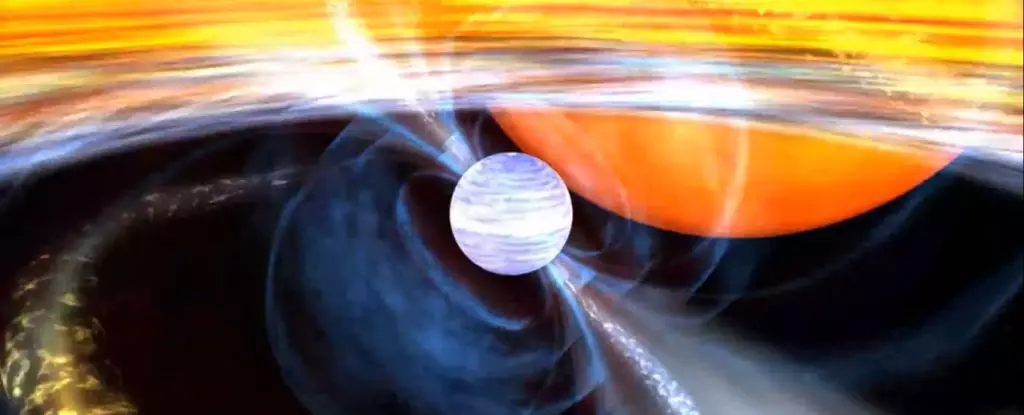In the vast reaches of our universe, where time and distance stretch the fabric of reality, a striking revelation has emerged from the binary star system known as 4U 1820-30, located an astonishing 27,400 light-years away. This unique system showcases the exotic life and death of stars, with its neutron star exhibiting unprecedented behavior—rotating at a staggering rate of 716 times per second. This remarkable finding, spearheaded by an expert team led by astrophysicist Gaurava Jaisawal from the Technical University of Denmark, not only challenges our existing understanding of stellar physics but also raises the bar for neutron star behavior.
The implications of this discovery are profound. While the famous pulsar PSR J1748-2446ad, a beacon in the study of astrophysics, previously held the record for rapid rotation, the behaviors observed in 4U 1820-30 suggest we are witnessing a remarkable display of stellar dynamics. Jaisawal’s team, originally investigating thermonuclear explosions from this binary system, stumbled upon these astonishing oscillations, opening new avenues for research into the characteristics of neutron stars.
Neutron stars are the remnants of massive stars that have undergone supernova explosions, marking one of the final stages in stellar evolution. When a star, typically between 8 to 30 solar masses, exhausts its nuclear fuel, it succumbs to the gravitational pressures that collapse its core. This core condenses into a neutron star, a highly dense entity that both fascinates and perplexes astrophysicists. With masses ranging from 1.1 to 2.3 times that of our sun crammed into a sphere a mere 20 kilometers in diameter, these stars embody extremes of density and gravitational forces that disrupt our conventional understanding of matter.
Within the realm of neutron stars, distinct categories exist—pulsars and magnetars highlight the diversity of their behaviors. Pulsars emit regular pulses of radio waves due to their rapid rotation, while magnetars possess exceptionally strong magnetic fields. The classification of these objects enables astronomers to study various astrophysical phenomena, providing insights that shape our comprehension of cosmic life cycles and element formation.
The binary system 4U 1820-30, situated in the constellation Sagittarius, is a complex interaction between a neutron star and a white dwarf star, which are in a close orbit of merely 11.4 minutes. This proximity facilitates a process known as mass transfer, in which the neutron star siphons off material from its companion, leading to increasingly dense layers accumulating on its surface. Eventually, this material reaches critical conditions, triggering dramatic thermonuclear explosions that can illuminate the surrounding cosmos.
The energy released during these explosions is staggering—up to 100,000 times brighter than our sun. During the analysis of these explosive events, Jaisawal and colleagues identified peculiar oscillations, which hinted at the neutron star’s rapid spin. Observing these oscillations, the research team postulated that the neutron star might be an X-ray pulsar, exhibiting rotational characteristics powered by the explosive events occurring in its vicinity.
Future of Neutron Star Research
The discovery of the oscillation pattern at 716 Hertz invites further scrutiny and observation. If additional studies confirm the hypothesis that 4U 1820-30 is indeed the fastest spinning nuclear-powered pulsar, it would revolutionize our understanding of stellar life cycles and neutron star dynamics. Precisely monitoring these pulsations and explosions can yield critical clues about the mechanisms occurring within neutron stars, potentially redefining conventional limits in astrophysics.
While our comprehension of these extraordinary cosmic objects has advanced, the examination of 4U 1820-30 serves as a reminder of the mysteries still lurking in the universe. It encapsulates the duality of destruction and creation within stellar evolution—how a star’s end can lead to discoveries with profound implications for our understanding of astrophysical processes.
As astronomers continue to unravel the threads of the universe’s tapestry, the ongoing investigations of neutron stars like 4U 1820-30 ensure that we remain on the edge of cosmic discovery, revealing the intricate dances performed by stars in their final act before fading into oblivion. The future of stellar research promises more surprises, each unveiling the magnificent intricacies of the cosmos that continuously captivates our imaginations.

